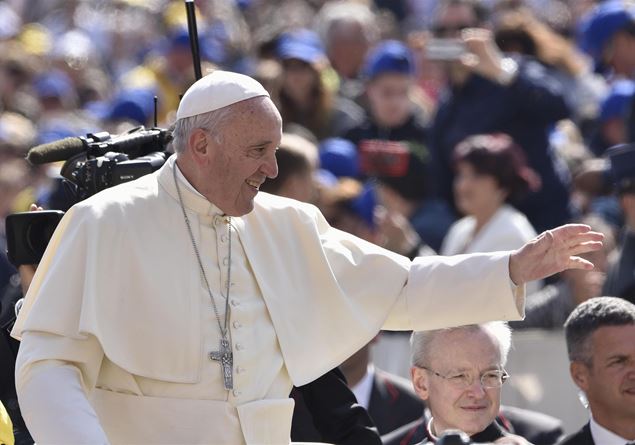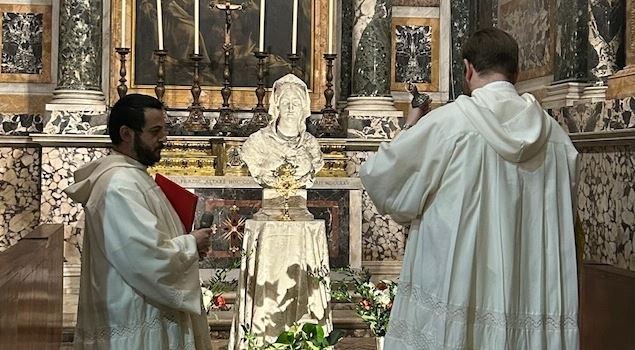Less than two years have passed since on Famigliacristiana.it We were reporting the discovery, after a scrupulous inventory among the uninseposed works of the Roman basilica of Santa Maria above Minerva, of A plaster sketch made by Vincenzo Jerace (1862-1947), a multifaceted artist fascinated by the natural sciences, originally from Polistena (Reggio Calabria), of the face of the Blessed Maria Cristina of Savoy.
Now, the work, which risked falling into oblivion, is exposed, in the Chapel of All Saints, decorated with valuable paintings and sculptures by the will of Pope Clement X (also the busts of the father and his brown brother of the Pope), to the right of the main altar of the historic temple, not far from the Pantheon, which holds the remains of figures of high spirituality, such as Santa Caterina da Siena, doctor of the Church, or the blessed Angelico, universal patron of the artists, and masterpieces known throughout the World, like the frescoes of Melozzo da Forlì or Filippino Lippi.
The bust of the “Reginella Santa”, as Benedetto Croce called it in a short essay that dedicated them in 1924, was discovered and blessed on Sunday 25 January, after the mass for the eleventh anniversary of the beatification of Maria Cristina (1812-1836)Queen of the two Sicilies, the latest of Vittorio Emanuele I, king of Piedmont and Sardinia, and first wife of Ferdinand II. Next to Blessed’s effigy were placed his relics. The ceremony was present a large representation of the culture conferences that bear the name of the sovereign and cultivate their memory. The sculpture returned to religious devotion but also to the appreciation of art scholars is actually a preparatory sketch for a monument that should have been erected in 1936, the first centenary of the death of Blessed Sabauda, in honor of which was also promoted to that ‘ Year a great exhibition, at the Royal Palace of Naples, the city where the artist resided, welcomed in his youth by his brother Francesco.
The paternity of the sketch is certain thanks to the signature engraved by Jerace himself, also famous for his whimsical liberty creations in marble, metal and ceramic, for the villas he designed in Campania and London And for monuments such as the Redeemer commissioned to him by the city of Nuoro for the 1900s Jubilee, the sculptural group of Sinite Parvulos, at the Forest Lawn Memorial Park in Cypress around Los Angeles and various works in memory of the fallen of the Great War erected in Calabria, his native land.
The exhibition of the bust whose face is faithful to Maria Cristina’s funerary cast, once again draws attention to the figure of this young queen, who died on January 31, 1836, just 23 years old, two weeks after the birth of the only child, Francis II, called “Franceschiello”, the last Bourbon king, dethroned by the distant cousins of his mother. Despite the young age, in Naples Maria Cristina created a series of humanitarian works, anticipating the orientation of socially engaged Catholicism spread at the end of the nineteenth century. He did not limit himself to economically supporting the destitute but wanted to change their living conditions. He opened mobiles and sweaters in Naples, revitalized the seteries of San Leucio in the Caserta giving work to the “last”, and reinvested the profits of these activities in other projects of charity. The love for others and humility animated Maria Cristina until the last breath, so much so that, during the agony asked forgiveness to all relatives and all the staff of the court for any shortcomings made. Just as he burned in her, until the end, the most complete trust in divine design: he goes out by repeating what was his motto for all the short earthly experience: “I believe in God, I love God, I hope for God”.
Words, it was remembered during the function of 25 January, they should inspire every devotee. Ferdinand II of which she had mitigated excesses and intemperances, in addition to having brought it closer to the faith (we recited the rosary together before each Council of State) declared to the beatification process: “Maria Cristina taught me to live and die”.








